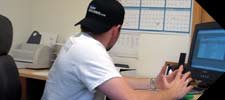These factors are, of course, essential, but what is not often thought addressed is the fact that our personality dictates how we respond to the these factors. Personality encompasses our emotions, thoughts, feelings, attitudes and perceptions. It is these things that really determine the quality and regularity of our training and diet and, ultimately, the sort of results we will achieve.
In fact, the most important element in terms of training program success is whether or not an individual has the motivation to continue. Sadly, the vast majority of programs are devised without any emphasis on the psychological temperament of an individual. By identifying ones personality characteristics and developing programs to suit their emotional, in addition to physical, needs, a higher degree of training success can be realized.

Types

 Personality types can include sad and depressed, perfectionist, shy, introverted, extroverted, uptight and angry, paranoid, ineffectual, loner and type A (a workaholic obsessed with productively). Every person, based on their personality type, is predisposed to seeing the world and its events in a specific manner.
Personality types can include sad and depressed, perfectionist, shy, introverted, extroverted, uptight and angry, paranoid, ineffectual, loner and type A (a workaholic obsessed with productively). Every person, based on their personality type, is predisposed to seeing the world and its events in a specific manner.
It follows that one particular training strategy may not necessarily be compatible to the how a particular individual thinks and feels. Conversely, training a certain way might actually intensify certain negative aspects of ones personality. For example, a perfectionist type might identify with a training program that emphasizes attention to detail. A weight-loss regimen a 3-percent body-fat percentage outcome, for instance.
However, extreme perfectionism is not a healthy state, so it might be best in this instance to perhaps focus on relaxation techniques and group training sessions or sports, to divert this persons attention away from their own self importance. Once the problematical aspects of perfectionism are addressed then specific, attention to detail style training can be introduced.
Indeed, modifying a training program to accommodate a specific personality type is not an easy task, but it can be done if one is versed on human psychology and desires to address all aspects of a training program. With this in mind we will look at the different personality types along with their strengths and limitations, and devise training strategies accordingly.

Personality

Everyone has certain personality traits that form their personality and make them unique. From birth, our personalities develop in response to our social and cultural environments. Our conception of right and wrong and how we view ourselves, and the world, are developed during this time, and have a tremendous bearing on the types of personality we will have as adults. Most of us end up with a combination of elements from all of the personality types discussed, but typically one element tends to predominate.
This blending of personality characteristics is normal and dictates how we respond to the world. Personality does become problematic when decidedly normal traits like anger, guilt, shyness and suspiciousness, for example, become clinically diagnosable conditions called personality disorders.
These disorders could be considered personality at its destructive extreme. At this extreme end of the personality continuum, personality disorders can range from mild to severe depending on how pervasive and to what extent a person exhibits the features of a particular personality disorder. Personality disorders include paranoid, narcissistic, borderline, histrionic, anti-social, obsessive compulsive, schizoid, schizo-typal and avoidant.
 Forming the basis of this article are personality types, not personality disorders. Types can be manageable to an extent, but disorders need professional attention. They are pervasive, chronic and psychological, and greatly affect a persons life, whereas types define who we are as people on a non-pathological level. Again, the training advice given in this article will apply to types.
Forming the basis of this article are personality types, not personality disorders. Types can be manageable to an extent, but disorders need professional attention. They are pervasive, chronic and psychological, and greatly affect a persons life, whereas types define who we are as people on a non-pathological level. Again, the training advice given in this article will apply to types.

Matching Personality To Training

Essentially, the following strategies, will serve to improve motivation levels. Motivation underpins our desire to begin training, and the level of intensity and concentration we apply to this training. Motivation is also inextricably linked to our underlying emotional needs.
In addition, strategies that help to create a more balanced perspective as far as training goes will be addressed. Overtraining and obsessiveness often stem from an overly enthusiastic approach to training. A positive balance should be reached to enhance motivation. Before reading the following strategies to determine whether any of these apply to ones particular personality type, one should engage in a little self analysis.
To determine the personality type/types closest to ones personal type, the following questions can be asked of oneself. The answers should provide greater personal insight, and help with determining which type/types of personality characteristics apply.
- Am I setting clear goals that are realistically achievable?
- Am I satisfied with my present lifestyle?
- Would I consider myself a perfectionist?
- What are my specific strengths and weaknesses?
- Am I flexible, or opposed to change?
- Is my personality a problem in any way?
- Am I always in a hurry?
- Do I worry excessively?
- Am I often sad?
- Am I distrusting of people?
- Would I consider myself to be a loner?
- Do I become anxious under conditions of stress?

Training Tips To Accommodate Personality Types

Once an individual has decided what type they are, a personal trainer, exercise consultant, or the individual in question can employ the following.
1: Sad & Depressed Type



Someone who never seems to feel satisfied with most aspects of their life. These people might try to blame others for their predicament and may experience a state of hopelessness and helplessness on a constant basis.
- Focus on changing the sad and depressed types mind-set thorough the encouragement of positive self affirmation and social skills learning. Self affirmation can include writing a number of weight-training goals, with desired outcomes, and having the individual recite these on a regular basis. Choose a sport of weight program where interaction with, and the helping of, others forms a large part.
- Focus on achievement throughout program. Set small goals and ensure that these are met.
- Choose a sport or weight training program that builds mastery and self-confidence.
2: Perfectionist Type



This person is never really happy with their performance or results because they aspire to largely unattainable goals, and cannot cope with anything less than perfection, which is, in itself unattainable. These people are almost impossible to live with as they expect perfection from others also.
- Design a program that emphasizes small, achievable, attainable, goals. Encourage contentment upon completion of these smaller goals. The perfectionist individual should be happy with what they have achieved, not unhappy with what they have not.
- Encourage team sport, to teach the value of teamwork to absorb the stresses associated with perfectionism.
- Factor in relaxation techniques such as meditation and visualization.
3: Shy Type



This person is prone to procrastination and will not undertake tasks or engage in social activities without social support. These people might feel inadequate and would prefer to deal with life's difficulties in a passive manner.
- Apply assertiveness training: facets of assertiveness addressed in assertiveness training include, speaking up and insisting on ones rights as a human being, showing both positive and negative emotions, and dealing with minor irritations before anger builds.
- Try to emphasize team training exercises to build confidence.
- Provide positive feedback wherever possible.
- Have shy-type train with an experienced trainer who can provide adequate support in the short-term.
- To have this individual train in a crowded gym on their own, would be an ideal long-range goal.
4: Uptight & Angry Type



Often overreacting with rage and easily upset, this person can be temperamental, verbally harsh, pushy, and impatient.
- Try to resolve underlying hostilities.
- Focus on the development of interpersonal skills throughout training program. Team sports and partner training would be ideal.
- Incorporate plenty of relaxation work: visualisation, meditation and slow breathing to channel energies away from the negative.
- Design session to be as intense as possible to counter the build-up of aggressive tension.
5: Paranoid Type



This person finds it hard to trust others and suspects an ulterior motive of anyone who tries to be friendly. These people feel that others negatively evaluate them, and find it hard to make friends as a result.
- Focus on activities that involve a reliance on others: heavy weight sessions with a capable spotter, river-rafting, and most team sports. Once physical security has been trusted to another, confidence around others should increase and distrust should attenuate.
- Identify underlying insecurities stemming from past relationship difficulties and try to address these.
6: Ineffectual Type



This person does not like facing difficult situations and may feel overwhelmed by anxiety when events become stressful.
- Focus on problem solving and fear confrontation: ensure that adequate support is in place during this time. Allow individual to help plan training program to assist confidence and impart a sense of control over ones environment.
- Opt for low-level aggression sports and activities, particularly during the early stages.
- Focus on group involvement.
- Have individual assume responsibility for program.
7: Loner Type



A loner type is withdrawn and has few friends. Solitary activities tend to be of importance to the loner and, like the ineffectual type, become easily discouraged when events become too stressful.
- Focus on social skill development: again, ensure a group environment or have individual train with an experienced personal trainer or gym enthusiast.
- Incorporate decision making opportunities into program to enhance the loners ability to make choices and their level of self-awareness.
8: Type A Personality



A type A personality is generally a workaholic obsessed with productively. These people cannot seem to slow down and often face the prospect of burn-out. Type A people often undergo high blood pressure, excessive stress, headaches and heart attacks.
- Training should incorporate fewer sets and and emphasis should be placed on correct breathing.
- Meditation and visualization can be employed to encourage a relaxed frame of mind.
- It would probably be best to discourage competitive sport of any type and instead focus on slow, non-competitive activities, and long-term goals to prevent the type A personality from trying to cram everything into one session.
- Change program regularly, and encourage flexibility.

Conclusion

When designing a training program, or indeed, planning for any type of sporting activity, a perceptive personal trainer or trainee, will factor in personality types to ensure that all aspects of the program are addressed. By developing greater insight into who we are, training weak points can be challenged, and overcome.
The reality is, as individuals, we are distinctly different in as many ways as there are grains of sand on the beach. These differences should be recognized at the program planning stage.
| Sad & Depressed Type | Perfectionist Type |
| Shy Type | Uptight & Angry Type |
| Paranoid Type | Ineffectual Type |
| Loner Type | Type A Personality |
References:
- Aronson, E.(1984). The Social Animal. WH Freeman and Co: USA.
- Eagly, A & Chaiken, S.(1993). The Psychology of Attitudes. HBJ: USA.
- Hall, C Lindzey, G, & Campbell, J.(1997). Theories of Personality. Wiley Test Books: USA.
- Siebert, A & Siegel, B.(1996). The Survivor Personality. Berkley Publishing Group: USA.
- Tristany, J.(1995). What's Your Bodybuilding Personality? Muscle and Fitness. Weider Publishing. USA.
